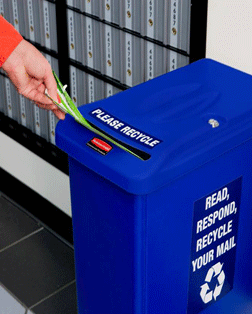Our Environment
Waste and Recycling
Reducing the waste we generate is central to becoming more sustainable. Last year, USPS generated an estimated 455,000 metric tons of municipal solid waste. We recycled approximately 232,000 metric tons of that waste.
Our integrated waste management program has demonstrated cost-effective and proactive pollution prevention and waste minimization, and promotes resource efficiency and reduction of environmental risks.
Raising awareness and encouraging behavior changes among employees, customers and business partners are central to our efforts. Our pollution prevention awareness and training program is targeted to all levels of employees to encourage waste prevention.
Recycling at Postal Facilities
About 60 percent of our 34,000 facilities have active recycling programs for one or more commodities. In addition, we’ve expanded our lobby recycling program, which allows customers to recycle mixed paper in Post Office lobbies, to almost 4,000 locations in 2008 ― an increase of 23 percent from 2005.
We’re developing strategies to expand recycling of undeliverable Standard Mail, discarded lobby mail and other paper, cardboard and plastics resulting from postal operations.
Targeting undeliverable Standard Mail and discarded lobby mail will help meet postal waste reduction cost goals. It also will result in more efficient and environmentally sound alternatives to solid waste disposal practices.
WasteWise Partnership
USPS received the EPA’s WasteWise Partner of the Year Award, the program’s highest honor, for the ninth year in a row. The WasteWise program targets reducing municipal solid waste and industrial wastes. Today, 100 percent of our districts are WasteWise partners, a substantial jump in participation over the prior year, when we had 11 percent of districts enrolled.
Reducing Waste
2008, USPS established a “zero waste to landfill” initiative to reduce the volume of solid waste generated from our Washington, DC, headquarters facility. The purpose of this initiative is to reduce as much as possible the amount of solid waste sent to landfills. We plan to expand the program to 19 pilot sites, including processing and distribution centers and vehicle maintenance facilities.
Managing Toxic and Hazardous Chemicals
USPS has developed a formal approach to toxic and chemical management through our chemical management plan, which establishes systems and internal controls.
We reached several major implementation milestones in 2008, including:

Almost 4,000 Post Offices are participating in our Post Office Box Lobby Recycling campaign that encourages customers to “Read, Respond and Recycle” their mail in our lobbies using our secure recycle bins.
- Identifying high-volume chemical and hazardous materials purchases and finding less toxic alternatives for each.
- Establishing goals and objectives for reduction or elimination of toxic and hazardous chemicals most frequently found within USPS. Our chemical reduction program focuses on 13 chemicals typically associated with vehicle maintenance, mail processing and custodial cleaning operations. This program replaced the Postal Service’s “17 Chemical Reduction Program” adopted in the early 1990s.
- Disseminating requirements on the reduction, release and use of toxic and hazardous chemicals, materials and products.
- Maintaining and updating facility-specific pollution prevention plans at our plants and vehicle maintenance facilities.
- Expanding the use of suppliers capable of providing high levels of reliable and cost-effective support services for the collection, recycling and proper disposal of universal, hazardous, regulated and special wastes throughout the nation.
|
|
|
